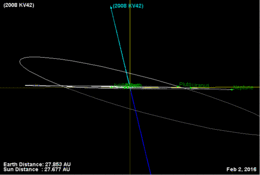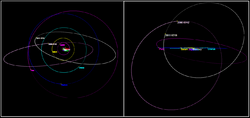Astronomy:(528219) 2008 KV42
 | |
| Discovery [1][2] | |
|---|---|
| Discovered by | Mauna Kea Obs. (uncredited: B. Gladman J. J. Kavelaars, J.-M. Petit) |
| Discovery site | Mauna Kea Obs. |
| Discovery date | 31 May 2008 |
| Designations | |
| (528219) 2008 KV42 | |
| 2008 KV42 · Drac [3] | |
| Minor planet category | Distant[2] · TNO[1] Centaur (DES)[4] Damocloid (outer)[5] |
| Orbital characteristics [1] | |
| Epoch 27 April 2019 (JD 2458600.5) | |
| Uncertainty parameter 3 | |
| Observation arc | 9.86 yr (3,601 days) |
| |{{{apsis}}}|helion}} | 62.235 AU |
| |{{{apsis}}}|helion}} | 21.121 AU |
| 41.678 AU | |
| Eccentricity | 0.4932 |
| Orbital period | 269.07 yr (98,279 days) |
| Mean anomaly | 337.93° |
| Mean motion | 0° 0m 13.32s / day |
| Inclination | 103.40° |
| Longitude of ascending node | 260.85° |
| 133.00° | |
| Uranus MOID | 4.24 AU[2] |
| TJupiter | −1.0160 |
| Physical characteristics | |
| Mean diameter | |
| Apparent magnitude | 23.2[7] |
| Absolute magnitude (H) | 8.8[1] |
(528219) 2008 KV42 (provisionally designated 2008 KV42, and nicknamed Drac[3]) is a trans-Neptunian object (TNO) and the first one with a retrograde orbit to be discovered. This retrograde motion with an orbital inclination of 103° suggests that it is the missing link between its source in the Hills cloud and Halley-type comets, thus providing further insight into the evolution of the outer Solar System. The object measures no more than 90 kilometers (56 miles) across. With a semi-major axis of 42 AU, it takes about 269 years to complete an orbit around the Sun.
Officially discovered on 31 May 2008, the discovery was announced on 16 July 2008, by the Canada–France Ecliptic Plane Survey team led by Brett Gladman. The discovery team nicknamed 2008 KV42 "Drac" after Count Dracula.
Discovery and naming
The discovery of 2008 KV42 was announced on 16 July 2008 by the Canada–France Ecliptic Plane Survey team led by Brett Gladman from the University of British Columbia.[8][9] The announcement was made during the "Asteroids, Comets, Meteors" meeting held in Baltimore, Maryland, followed by a Minor Planet Electronic Circular on the same day and an IAU Circular on 18 July. The discovery was made using images obtained on 31 May from the 3.5 meter Canada-France-Hawaii Telescope, followed by further observations until 8 July from the Whipple Observatory and Cerro Tololo.[8][10][11]
The discovery team nicknamed 2008 KV42 Drac because of its high inclination in reference to its orbital plane resembling Count Dracula's ability to walk on walls.[12]
Orbit
2008 KV42 is the first trans-Neptunian object (TNO) with a retrograde orbit to be discovered. With a semi-major axis of 41.7 AU,[1] it was discovered while at a distance of 32 AU and has a perihelion at roughly the distance of Uranus.[8]
The object's 103-degree inclination makes its almost perpendicular to the ecliptic, and is, as of July 2017, one of only six objects known to have inclination (i) > 60° and perihelion (q) > 15 AU. The other six[13][14] are: 2002 XU93,[15] 2007 BP102,[16] 2010 WG9,[17] 2011 KT19,[18] 2014 LM28.[19]
Its unusual orbit suggests that 2008 KV42 may have been perturbed inwards from its source, most likely in the Hills cloud, by an unknown gravitational disturbance. Its discovery may reveal the source regions for Halley-type comets which also have an retrograde orbit, but their origin remains unknown. 2008 KV42 itself is believed to be in an intermediate stage towards becoming a comet, thus helping to further explain the formation and evolution of the outer Solar System.[6][20][3]
Planet Nine
2008 KV42 may even provide evidence of Planet Nine.[21] The Kozai effect inside the mean-motion resonances with Planet Nine may cause a periodic exchange between its inclination and its eccentricity. When the elongated perpendicular centaurs get too close to a giant planet, orbits such as that of 2008 KV42 are created.[22]
See also
References
- ↑ 1.0 1.1 1.2 1.3 1.4 "JPL Small-Body Database Browser: (2008 KV42)". Jet Propulsion Laboratory. https://ssd.jpl.nasa.gov/sbdb.cgi?sstr=3418144. Retrieved 29 May 2019.
- ↑ 2.0 2.1 2.2 "2008 KV42". Minor Planet Center. 10 April 2018. https://www.minorplanetcenter.net/db_search/show_object?object_id=2008+KV42. Retrieved 20 December 2018.
- ↑ 3.0 3.1 3.2 Gladman, B. (2009). "Discovery of the First Retrograde Transneptunian Object". The Astrophysical Journal 697 (2): L91–L94. doi:10.1088/0004-637X/697/2/L91. Bibcode: 2009ApJ...697L..91G.
- ↑ Marc W. Buie (8 July 2008). "Orbit Fit and Astrometric record for 08KV42". SwRI (Space Science Department). http://www.boulder.swri.edu/~buie/kbo/astrom/08KV42.html. Retrieved 15 September 2008.
- ↑ Akimasa Nakamura and bas (2 May 2009). "List of Damocloids (Oort cloud asteroids)". Lowell Observatory. ftp://ftp.lowell.edu/pub/bas/damocloid. Retrieved 15 February 2017.
- ↑ 6.0 6.1 "Discovery of the retrograde trans-neptunian object 2008 KV42". Canada France Ecliptic Plane Survey. 2008. http://www.cfeps.net/KV42_Press.html. Retrieved 23 July 2014.
- ↑ "2008KV42 ephemeris". Universita di Pisa. https://newton.spacedys.com/astdys/index.php?pc=1.1.3.0&n=2008%20KV42. Retrieved 20 December 2018.
- ↑ 8.0 8.1 8.2 "A Retrograde TNO : 2008 KV42". Canada France Ecliptic Plane Survey. 2008. http://www.cfeps.net/Notable_Discoveries/Entries/2008/7/16_2008_KV42_-_a_retrograde_TNO.html. Retrieved 23 July 2014.
- ↑ Hecht, Jeff (5 September 2008). "Distant object found orbiting Sun backwards". New Scientist. https://www.newscientist.com/article/dn14669-distant-object-found-orbiting-sun-backwards.html#.U9AiBbEQvDt. Retrieved 23 July 2014.
- ↑ "MPEC 2008-O02 : 2008 KV42". Minor Planet Center. 16 July 2008. https://www.minorplanetcenter.net/iau/mpec/K08/K08O02.html. Retrieved 23 July 2014.
- ↑ "Circular No. 8960". Central Bureau for Astronomical Telegrams. 18 July 2008. http://www.cbat.eps.harvard.edu/iauc/08900/08960.html. Retrieved 23 July 2014.
- ↑ O'Neill, Ian (5 September 2008). "Kuiper Belt Object Travelling the Wrong-Way in a One-Way Solar System". Universe Today. http://www.universetoday.com/17712/kuiper-belt-object-travelling-the-wrong-way-in-a-one-way-solar-system/. Retrieved 24 July 2014.
- ↑ "MPC list of q>15 and i>60 (HiHq objects)". IAU Minor Planet Center. http://minorplanetcenter.net/db_search/show_by_properties?perihelion_distance_min=15&inclination_min=60. (a 7th object appears to be removed, 2010 TH192)
- ↑ "JPL Small-Body Database Search Engine: i > 60 (deg) and q > 15 (AU)". JPL Solar System Dynamics. http://ssd.jpl.nasa.gov/sbdb_query.cgi?obj_group=all;obj_kind=all;obj_numbered=all;OBJ_field=0;ORB_field=0;combine_mode=AND;c1_group=ORB;c1_item=Bj;c1_op=%3E;c1_value=60;c2_group=ORB;c2_item=Bi;c2_op=%3E;c2_value=15;table_format=HTML;max_rows=50;format_option=comp;c_fields=AcBhBgBjBiBnBsCkCqAiBq;.cgifields=format_option;.cgifields=obj_kind;.cgifields=obj_group;.cgifields=obj_numbered;.cgifields=combine_mode;.cgifields=ast_orbit_class;.cgifields=table_format;.cgifields=com_orbit_class&query=1&c_sort=AcA. Retrieved 29 May 2013.
- ↑ 2002 XU93, ssd.jpl.nasa.gov
- ↑ 2007 BP102, ssd.jpl.nasa.gov
- ↑ 2010 WG9, ssd.jpl.nasa.gov
- ↑ 2011 KT19, ssd.jpl.nasa.gov
- ↑ 2014 LM28, ssd.jpl.nasa.gov
- ↑ "Announcements – International Team of Astronomers Finds Missing Link". National Research Council. 4 September 2008. http://archive.nrc-cnrc.gc.ca/eng/news/hia/2008/09/04/asteroid-2008kv42.html. Retrieved 26 July 2014.
- ↑ Batygin, Konstantin; Brown, Michael E. (20 January 2016). "Evidence for a distant giant planet in the Solar system". The Astronomical Journal 151 (2): 22. doi:10.3847/0004-6256/151/2/22. Bibcode: 2016AJ....151...22B. (called drac in reference)
- ↑ "Why I believe in Planet Nine.". FindPlanetNine.com. 12 February 2016. http://www.findplanetnine.com/2016/02/why-i-believe-in-planet-nine.html.
<ref> tag with name "SFASU-DCalc" defined in <references> is not used in prior text.External links
- (528219) 2008 KV42 at AstDyS-2, Asteroids—Dynamic Site
- (528219) 2008 KV42 at the JPL Small-Body Database


